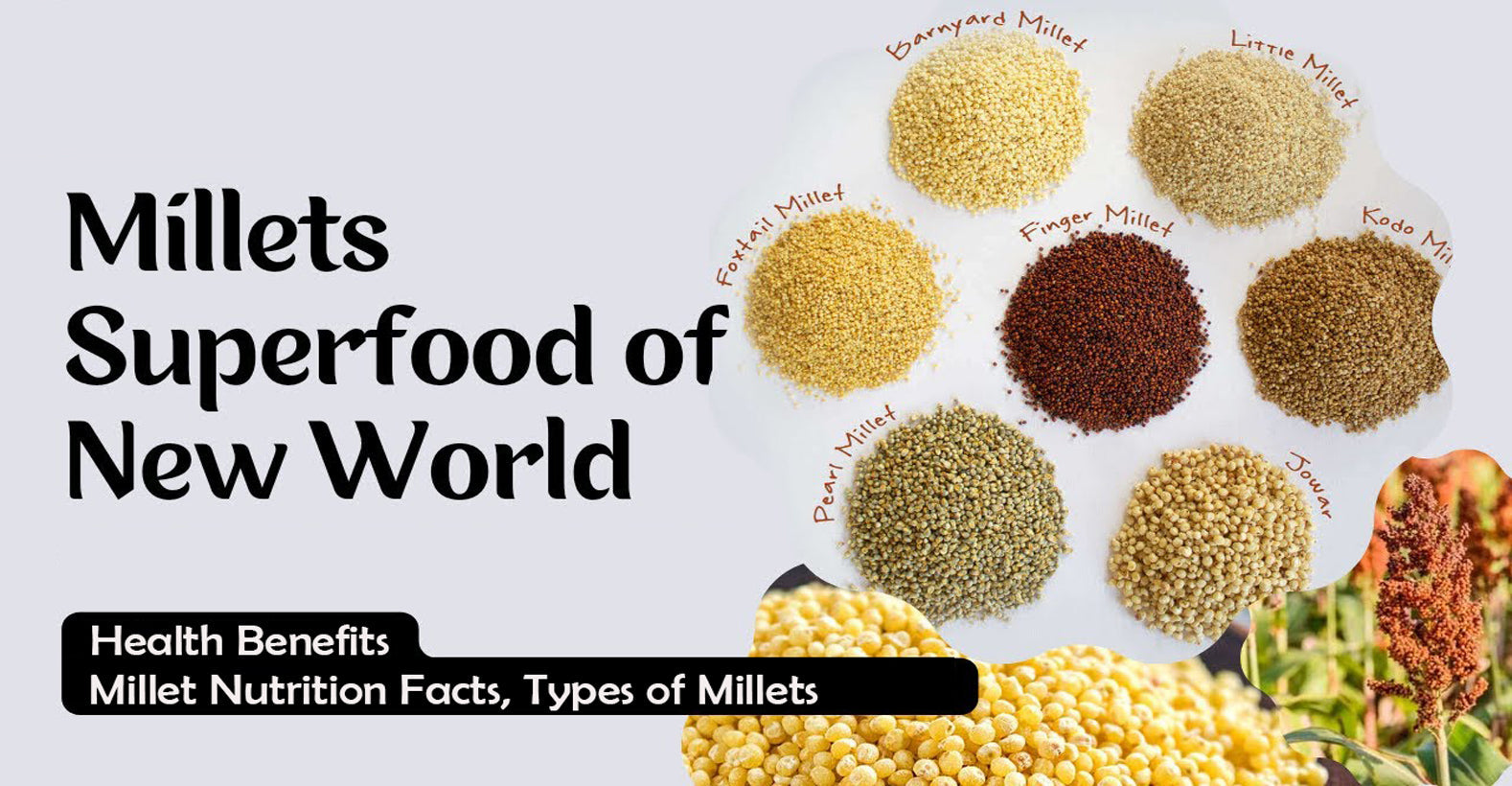What are Millets? Types of Millets with Health Benefits?
Millets are a family of ancient and tiny grains that have existed for thousands of years. Millets are a staple in numerous diets worldwide and have immense health benefits. It contains a lot of nutritional value and offers an enormous spectrum of choices regarding healthy food. On top of all these, millets do not have gluten content and, therefore, can be helpful for patients having gluten intolerance or celiac disease.
In this blog, we will discuss all types of Millets, health benefits of Millets, nutrition information accessible through the varied kinds, and an inventory list of how to cook Millets.

Types of Millets:
There are many types of Millets, and specific kinds of Millet give you some enriching nutritional count. Here, we talk about certain particular types of Millets:
-
Pearl Millet (Bajra): It is full of extreme fiber, iron, and magnesium and easily accessible. Bajra is mainly prepared to form flatbreads and porridge.
-
Finger Millet (Ragi): Ragi millet is replete with minerals and nutrients. It is mainly prepared for porridge, biscuits, and bread.
-
Foxtail Millet: It contains protein fiber and a low glycemic index, making it advisable for diabetic patients. It can be used in salads, stir-fries, or soups.
-
Kodo Millet: Compared to almost all millets, Kodo millet contains many antioxidants, protein, and fiber; that is why it supports good digestive health and blood cholesterol balance.
-
Barnyard Millet: It is rich in fiber and has zero or minimal calorie intake, almost nil. It's marvelous for weight loss and is cooked chiefly more often in khichdi and upma, savory dishes.
-
Little Millet: It is one of the smallest grains of Millet. It is very rich in antioxidants, which makes it healthy for heart issues. It can be used in soups, curries, or salads.
Health Benefits of Millets:
Millets are nutritionally rich, but they have also gained innumerable health benefits. Here are we explain some of the primary health benefits of millets:
-
Gluten-Free Grains: Millet is a gluten-free grain. It is beneficial to people who are suffering from gluten sensitivity or celiac disease.
-
Good for Weight Loss: Millets contain enormous amounts of fiber and stay in a high position long. This helps reduce urges, and you never overeat, which is good for weight loss. Millets also have low glycemic indices that help people control blood sugar levels.
-
Rich in Nutrients: Dense millets are packed with nutritional fiber, proteins, iron, magnesium, and many other vitamins. These nutrients are obviously needed for a person's life and health.
-
Improves Digestive System: Millets contain high fiber, which aids in digestion. Intake of Millet also improves digestive health and reduces the possibility of diseases related to digestive health.
-
Controls Blood Sugar: The millets have a very low glycemic index, which never lets the blood sugar speed high. Therefore, it is a delicious food for diabetes-prone individuals who already have diabetes.
-
Boosts Heart Health: Millets have rich antioxidant effects and reduce inflammatory effects, thereby preventing heart disease. It also has a very high fiber content. Fiber intake lessens cholesterol in the blood, which indirectly supports heart health.
-
Rich in Antioxidants: Millets are highly rich in antioxidants. The more antioxidants, the lower the body's oxidative stress level.
-
Supports Bone strength: Millet, particularly ragi or finger millet, is rich in calcium, the element needed to develop bones and establish health and strength. Taking Millet ensures that no disease, such as osteoporosis, can attack.
Millet Nutrition Facts:
Millets can be termed superfood since the nutritional benefits from these are high. Some crucial Millet nutrition facts include the following:
-
Calories: The caloric value in millets is relatively lower than any other form of grain. So, because of this factor, people might consume Millet freely because they maintain a low weight.
-
Protein: Millets are excellent sources of plant-based proteins required for building and repairing muscles.
-
Fiber: The millets comprise all types of dietary fibers, which enhance digestion and help maintain healthy body weight.
-
Vitamins and Minerals: Millets are a great source of vitamins and minerals, such as iron, magnesium, potassium, and B vitamins.
-
Antioxidants: Millet contains many varieties of antioxidants, which allow the human body to neutralize any free radicals.
Millets vs Rice:
Millets are much healthier than rice. Rice is a starch product, and within a short while, the rate of blood sugar increases. The glycemic indexes of Millet are low while very high on fiber, vitamins, and minerals. Millets have more nutritional aspects than rice, meaning they are far healthier than rice. Millets are among the best options for those seeking more nutritious diets.
How to Cook Millets:
Millets are very easy to cook. Millets are versatile and flexible because they can be prepared in almost any style one desires. Here, we discuss some simple Millet recipes followed by people:
-
Millet Porridge: This recipe is simple to prepare. First, you can wash 1 cup of Millet, boil it with 2 to 3 cups of water or milk, and leave it to sit for 15-20 minutes until it softens enough to consume liquids. You can also add fruit, nuts, and sweeteners.
-
Millet Salad: You can cook the Millet according to the packet and let it cool. Then, mix the fresh veggies, herbs, and homemade dressing and serve as a salad.
-
Millet Upma: Millet upma is an Indian savory preparation using already cooked Millet. It is fried with added vegetables, spices, and minimal oil on top, making it a lovely breakfast or lunch.
-
Millet Biryani: You can use Millet as the base material to prepare your version of rice biryani. Steam-cook millets mixed with spice powder, various vegetables, and a protein according to your liking.
Millet Recipes
Millets can be cooked in different recipes ranging from savory dishes, upma, or biryani to puddings and other sweets. Here are some interesting recipes that involve Millet:
-
Millets Khichdi: This steaming hot, delicious, comforting dish features millets, lentils, and various spices.
-
Millet Pancakes: Thin and fluffy pancakes made of gluten-free Millet.
-
Stir-fried Millet with veggies: You can quickly and easily make this recipe using your favorite vegetables.
Conclusion
Millets are a healthy grain. You can use Millets for weight loss. You can use Millet for easy digestion or to control blood sugar levels. Millets are considered the most nutritious food one should have for the body.
Different varieties of Millet are present, making it effortless to make their presence felt in your daily diet using various millet-based dishes. So the next time you need healthy substitutes for rice or wheat, Millet should always be considered a healthy gluten-free grains.
Where to buy Millets from?
If you are searching for millets online or would like to get high-quality grains, you can visit Dista(www.distacart.com). We have varieties that will help you enjoy well-preserved, nutritionally rich grains in your meal. So, do not wait. Order Millet Foods now.
Millets are available in lots of varieties. Every millet has its health benefits. Generally, all types of millet grains promote good health and wellness. They usually contain antioxidants, proteins, micronutrients, and a horde of other advantageous vitamins for our body.
Don’t wait, embrace a diet of millets and bring positive health changes.














